#Rue Becquerel
Explore tagged Tumblr posts
Text

Rue Becquerel, Montmartre, Paris France: Here is a short street in Montmartre. The street was named in 1875 after Antoine Becquerel (1788-1878), a physicist, the 1st of a dynasty of scientists that would see its apotheosis with the attribution of the Nobel Prize in 1903. The street, despite its barely 161 meters, still has a few surprises in store for us. As long as you are sensitive to ghosts, you will not fail to meet some of them, and not the least: Louise Michel, Nadja, Eluard, Gala, Dali... Rue Becquerel is a street in the 18th arrondissement of Paris, France. Wikipedia,
103 notes
·
View notes
Text


Plaque en hommage à : Pierre et Marie Curie
Type : Lieu de résidence
Adresse : 24 rue de la Glacière, 75013 Paris, France
Date de pose : Inconnue
Texte : En 1898, Pierre et Marie Curie habitaient cet immeuble lorsqu'ils découvrirent le radium à l’École supérieure de physique et de chimie de Paris
Quelques précisions : Pierre (1859-1906) et Marie Curie (1867-1934) sont deux physiciens/chimistes français, connus comme l'un des couples les plus emblématiques de la vie scientifique française. Tous deux ont obtenu en 1903 le prix Nobel de physique (qu'ils partagent avec Henri Becquerel) pour leur travaux sur la radioactivité. Ils se rencontrent dans les années 1890, alors qu'ils travaillent tous deux à l'École municipale de physique et de chimie industrielles (aujourd'hui ESPCI Paris), et ils se marient en 1895. Quoiqu'ils aient chacun mené des recherches individuelles de leur côté, ils sont aujourd'hui principalement commémorés dans l'imaginaire populaire pour leurs travaux communs sur les éléments radioactifs (incluant la découverte du polonium et du radium). Encore aujourd'hui, l'image de ces deux chercheurs partageant leur vie au laboratoire comme en-dehors, une période qualifiée d'exaltante par les deux intéressés, continue à susciter l'admiration du public. Leur histoire commune prendra toutefois tragiquement fin lorsque Pierre décède des suites d'un accident de la circulation. L'une de leurs filles, Irène Joliot-Curie, recevra comme ses parents un prix Nobel (en chimie). L'université de Paris VI (aujourd'hui la faculté des sciences de Sorbonne Université) porte longtemps leur nom. Marie Curie est également honorée par deux autres plaques commémoratives à Paris, quai de Béthune (4ème arrondissement) et avenue Jean Jaurès (19ème arrondissement), où elle vécut également.
#collectif#couple#residence#scientifiques#physiciens#chimistes#nobel#ile de france#france#paris#pierre curie#marie curie#non datee
2 notes
·
View notes
Photo
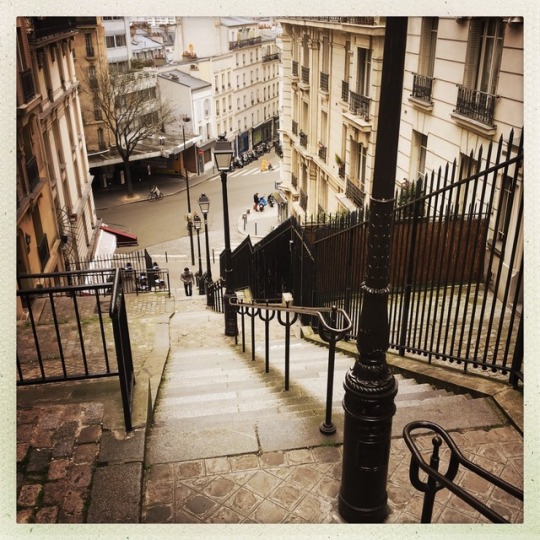
3 notes
·
View notes
Photo

[OC] France - Paris 18 - Street-art along the stairs of rue Becquerel by @wyvi_agency
17 notes
·
View notes
Text









Pierre Curie (1859-1906).
French physicist.
.
He was a French physicist, a pioneer in crystallography, magnetism, piezoelectricity, and radioactivity. In 1903, he received the Nobel Prize in Physics with his wife, Marie Skłodowska-Curie, and Henri Becquerel. The curie, a unit of radioactivity, was named after him.
He and Marie discovered radium and polonium in their investigation of radioactivity. An exceptional physicist, he was one of the main founders of modern physics.
.
By the age of 18, he earned a higher degree, but did not proceed immediately to a doctorate due to lack of money. Instead, he worked as a laboratory instructor.
.
Pierre Curie’s two main scientific partners throughout his career were his wife, Marie, and his brother, Jacques. Together with Jacques, Curie explored crystallography, through which he discovered piezoelectric effects. Curie showed that the magnetic properties of a given substance change at a specific temperature—a level now known as the Curie point.
.
Curie conducted his studies of radioactive substances with his wife, and the pair overcame the challenges posed by inadequate lab equipment and heavy teaching schedules to succeed in isolating the elements of radium and polonium (Marie Curie named polonium after her native country, Poland). The Curies went on to describe many of the novel properties of radium, which would form the basis of subsequent research in the fields of nuclear physics and chemistry.
.
He was introduced to Maria Skłodowska by their friend, physicist Józef Wierusz-Kowalski. Curie took her into his laboratory as his student. He began to regard Skłodowska as his muse. She refused his initial proposal, but finally agreed to marry him in 1895.
The Curies had a happy, affectionate marriage, and they were known for their devotion to each other. They had two daughters.
.
Pierre Curie died in a street accident in Paris on 19 April 1906. Crossing the busy Rue Dauphine in the rain at the Quai de Conti, he slipped and fell under a heavy horse-drawn cart. He died instantly when one of the wheels ran over his head, fracturing his skull.
[Submission]
#pierre curie#19th century#1900s#early 20th century#20th century#20th century history#belle epoque#french history#france#science history#history#history nerd#history geek#history lover#history hottie#history crush#historical crush#historical babes#historical hottie#historical figure
28 notes
·
View notes
Text
Notes on ‘Hoping this Finds You...’
Every slide in ‘Hoping this Finds You’ contains at least three clues- the ‘hoping this finds you’ tagline, the author of the note, and at least one thing in the note itself. But many of them contain 4, 5, 6+ clues, some of which are less obvious, and which may be buried in the text, intentional spelling modifications, capitalized words, or even the choice of the background paper. I thought it might be fun to outline where all those Easter eggs are hidden.
Slide #1: Abe Lincoln

Text Clues: ‘Appomattox Courthouse’- site of the final major battle of the Civil War, April 1865; ‘Passage of the Amendment’- a reference to the late January 1865 passage of the 13th Amendment by the House of Representatives (and a nod to the movie ‘Lincoln’); ‘I am sorry that I can’t join you in the district tonight’- Grant was originally supposed to be with Lincoln at Ford’s Theater on April 14th, but decided, instead, to travel to New Jersey to visit family; ‘Give my best to Tad and Mary’- Lincoln’s son and wife.
Hoping this finds you reference: Lincoln, a big fan of the theater, was assassinated at a showing of ‘My American Cousin’ on April 14, 1865 at Ford’s Theater.
Signatory- General Ulysses Grant, Lincoln’s commander of the Union Army.
Slide #2: Mikhail Gorbachev
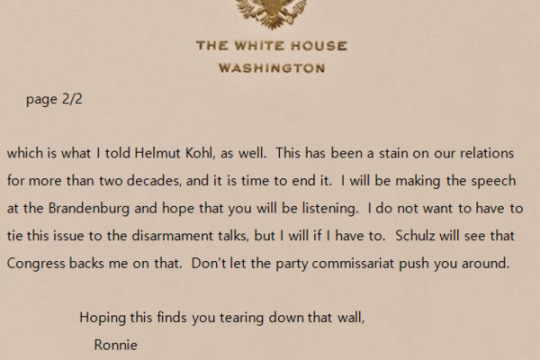
Background clue: White House letterhead
Text clues: ‘what I hold Helmut Kohl’- Kohl was German Chancellor from 1982 to 1998; ‘strain on our relations for more than two decades’- the Berlin Wall stood from 1961 to 1989; ‘making the speech at the Brandenburg’- Reagan’s famous ‘tear down this wall’ speech was made with the Brandenburg Gate in the background; ‘tie this issue to the disarmament talks’- The Reykjavík Summit was held in October 1986, just a few months before the ‘tear down this wall’ speech; ‘Schulz will see that Congress back me on that’- George Schulz was Reagan’s Secretary of State from 1982-1989; ‘party commissariat’- the term ‘commissariat’ had actually been replaced with the word ‘ministry’ by the 1980s, but being a term uniquely connected to the Soviet governmental structure, it made for a better clue.
Hoping this finds you reference: A direct reference to the 1987 ‘tear down this wall’ speech.
Signatory: Reagan, who was called ‘Ronnie’ by his wife Nancy and closest friends.
Slide #3: Marie Curie
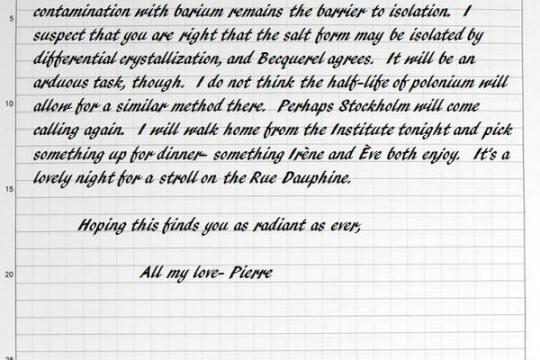
Background clue: A lab notebook! (Probably a bit modern for the Curies)
Text clues: ‘contamination with barium’- The late 1890s attempts by Marie and Pierre Curie to isolate radium were complicated because attempts to separate radium from pitchblende often resulted in barium contamination; ‘salt form may be isolated by differential crystallization’- the Curies eventually settled on the difficult and slow process of using differential crystallization to separate pure radium, but got only one tenth of a gram of pure radium from two thousand pounds of pitchblende; ‘Becquerel agrees’- I have no idea what Henri Becquerel thought about this process, or if he even knew, but he shared the 1903 Nobel Prize in Physics with the Curies, based on his early work on radioactivity, and this was a chance to include him as a clue to narrow the focus on Pierre and Marie; ‘do not think the half-life of polonium will allow for a similar method’- The Curies were never able to isolate pure polonium because it has a half-life of only about four months; ‘something Irene and Eve both enjoy’- The names of the Curie’s daughters; ‘lovely night for a stroll on the Rue Dauphine’- This is a bit dark, and actually made me choke up a bit doing it, but Pierre Curie was killed when struck by a carriage on the Rue Daupine in April, 1906.
Hoping this finds you reference: Curie won two Nobel Prizes and is known for her work in radioactivity. She died as a result of aplastic anemia from radiation exposure.
Signatory: Her husband, and fellow Nobel winner, Pierre.
Slide #4: Julius Caesar

Text clues: ‘display at the Circus Maximus’- The Roman chariot racing stadium; ‘this new calendar’- The Julian calendar was proposed and adopted by Caesar in 45 BC; ‘dictator in perpetuity’- Shortly after the adoption of that calendar, Caesar was granted the status of dictator in perpetuity; ‘war against the Parthians’- Parthia was a kingdom near the Caspian Sea in present day Iran. Caesar was planning an assault there at the time of his assassination; ‘set up a time with Brutus’- Merely a reference to Brutus and to Caesar’s famous line ‘Et tu, Brute’ from Shakespeare’s ‘Julius Caesar’; ‘Looking forward to seeing you at the Senate this evening’- Caesar was killed at the Senate on March 15, 44 BC.
Hoping this finds you reference: As noted, above, Caesar was killed on the Ides of March, thus the famous saying, ‘Beware the Ides of March’.
Signatory: Mark Antony, one of Caesar’s generals and political allies, who commanded the eventual war against Parthia. I chose him, specifically, so that I could use him as a double signatory for the Cleopatra slide as well.
Slide #5: Amelia Earhart
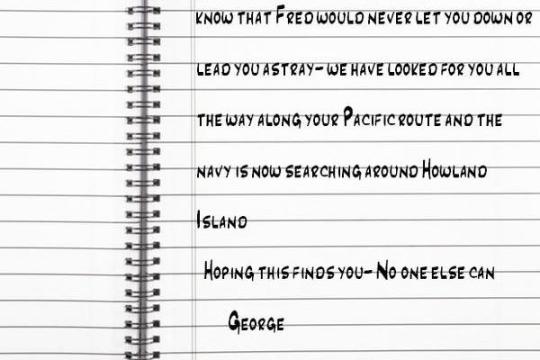
Text clues: ‘Fred would never let you down or lead you astray’- Fred Noonan was Earhart’s navigator on her fateful last flight; ‘have looked for you all the way along your Pacific route’- a reference to the search for Earhart after her disappearance; ‘searching around Howland Island’- A designated refueling stop on her flight, but a location which she never reached.
Hoping this finds you reference: Simply a note that Earhart has never been found.
Signatory: Her husband, George.
Slide #6: The Wright Brothers

Text clues: ‘Thrilled to hear the news from Kitty Hawk’- The Wright Brothers’ first successful powered flight came on the beaches at Kitty Hawk, NC; ‘The bike shop is holding up’- The brothers operated a bicycle shop in Dayton, Ohio, which still stands today and is open to tourists; ‘regular contact with the Air Corps’- The Brothers sold technology, and entire aircraft, to the Army Air Corps.
Hoping this finds you reference: The Brothers had just completed their first successful powered flight and were constantly attempting longer and higher flights (which were generally successful).
Signatory: Hart O. Berg, the Wright Brothers’ business manager in Europe, and his wife, Edith, who also managed European business for them, was the first American woman to fly in a plane. (Odd historical note, Sarah Van Deman, the daughter-in-law of John Van Deman, who built my house, and lived in it from 1878-1921, was the first woman to fly in a plane in the United States. John’s son, Ralph, was an Army Captain.)
Slide #7: Napoleon Bonaparte

Text clues: ‘he may rule France in the future’- This text snippet (meant to insinuate that this is a segment of the note) is a reference to Napoleon’s son; ‘Reports from Borodino’- The Battle of Borodino, September 7, 1812, was the deadliest battle of the Napoleonic Wars, but also a tactical victory for the French; ‘that traitor, Alexander’- Tsar Alexander had been an ally of the French, but relations broke down, leading to Napoleon’s invasion of Russia; ‘Perhaps Moscow can be our capital in the east’- French forces, following the Battle of Borodino, were mounting their assault on Moscow.
Hoping this finds you reference: Napoleon did not enjoy the French winter.
Signatory: Marie Louise, Napoleon’s 2nd wife.
Slide #8: Ferdinand Magellan

Background clue: An old naval map
Text clues: ‘that idiot Manuel’- A reference to the King of Portugal, who declined the opportunity to fund Magellan’s attempt to find a westward route for the spice trade; ‘There is move afoot to name the strait after you’- Of course, this wouldn’t happen until much later, but the passage around S. America is now known as the ‘Straight of Magellan’; ‘converting the Cebu’- Magellan and his men had successfully converted the Cebu tribe to Christianity; ‘similar success with the Mactan’- Magellan would definitely not have similar success with the Mactan’ ‘circumnavigation and the spice trade’- I couldn’t really make Magellan any more obvious than this.
Hoping this finds you reference: Magellan’s attempts to convert the Mactan led to battle, during which he was killed with a spear, thus ‘in good spear-its’.
Signatory: King Carlos I of Spain, benefactor of Magellan’s circumnavigation.
Slide #9: Lady Godvia

Text clues: ‘I have reduced the taxes’- The legend of Lady Godiva, almost certainly apocryphal, is that she was angry at her husband for overtaxing the poor and he made a bet with her that if she rode naked, on horseback, through the town, he would reduce the taxes. According to the legend, she did; ‘you may donate as much of our wealth as you like to the churches’- She was also famously a benefactor of local religious institutions; ‘I have even freed the peeping tailor’- The legend also provides that Godiva made an edict before her ride requiring all of the townspeople to stay inside with their shutters closed. A tailor named ‘Tom’ was the only one to break the rule. This is where we get the phrase ‘peeping Tom’ from; ‘do not embarrass the Earldom of Mercia’- Godiva’s husband was the Earl of Mercia.
Hoping this finds your reference: The Earl would, of course, want Godiva off the horse and wearing some clothing.
Signatory: Leofric, Godiva’s husband, and the Earl of Mercia.
Slide #10: William Howard Taft

Text clues: ‘agree with you about the income tax’- Taft was opposed to the institution of a national income tax, believing it unconstitutional; ‘ratification of the 16th A. has certainly settled the issue’- To address the claim of unconstitutionality, Congress adopted, and the states ratified, the 16th Amendment in 1913; ‘trade agreement with Canada’- Taft was, at that time, working on a free trade agreement with Canada; ‘dream of a Supreme Court appointment- Taft is most famous for being the only person to be both U.S. President and Chief Justice of the U.S. Supreme Court.
Hoping this finds you reference: The story is apocryphal, but Taft is also known for his girth, and thus the legend that he got stuck in the White House bathtub. There is no indication that it ever actually happened.
Signatory: Philander Knox, Taft’s Secretary of State.
Slide #11: Cleopatra

Text clues: ‘do not think is wise to have Herod visit again’- Herod famously visited Egypt in 40 BC, then traveled on to Rome. He and Cleopatra had competing claims to territory; ‘Octavian is quite pleased with the invasion of Armenia’- Octavian was heir to the Roman throne, and would have been quite pleased with the 34 BC invasion of Armenia, which Cleopatra funded; ‘call on your aid to support the cost of our armies’- see previous note about the Armenian invasion; ‘Ptolemaic Dynasty’- Cleopatra was the last of the Ptolemaic leaders before direct Roman rule; ‘Your story is Taylor made’- Cleopatra has frequently been the subject of modern artistic depictions, most famously the 1963 film starring Elizabeth Taylor.
Hoping this finds you reference: Cleopatra committed suicide (likely by poison), essentially ending the Hellenistic period.
Signatory: Mark Antony, Cleopatra’s third and final spouse.
Slide #12: Neil Armstrong
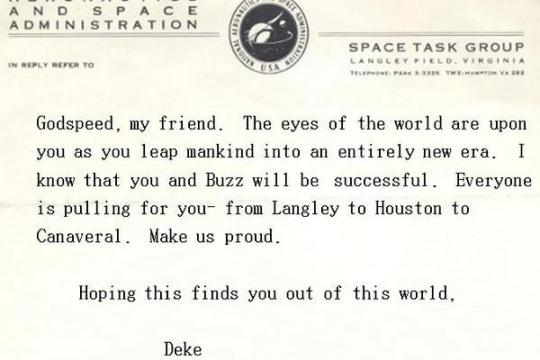
Background clue: NASA Space Task Group letterhead, in use from 1958-1962, and again for the Apollo program beginning in 1969.
Text clues: ‘leap mankind’- A reference to ‘one giant leap for mankind’, Armstrong’s famous words when first setting foot on the moon; ‘you and Buzz will be successful’- Buzz Aldrin was the command module pilot on Apollo 11, and the 2nd man to walk on the moon; ‘Langley to Houston to Canaveral’- All of the space command locations in 1969.
Hoping this finds you reference: Neil was certainly ‘Out of this world’ when landing on the moon.
Signatory: Deke Slayton, Air Force pilot, Mercury 7 astronaut, Chief of the Astronaut Office, Director of Flight Crew Operations, and Apollo-Soyuz astronaut.
Slide #13: Al Gore
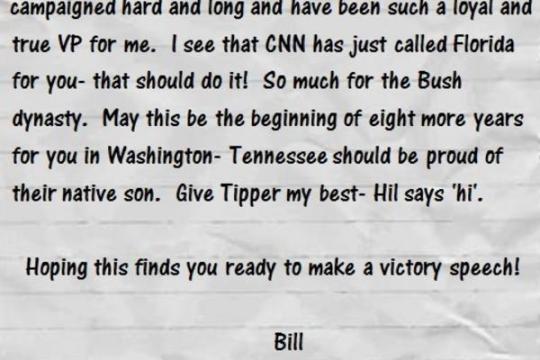
Text clues: ‘campaigned long and hard’- Immediately narrows to a politician; ‘been such a loyal and true VP’- further narrows to Vice-Presidents; ‘CNN has just called Florida’- Most news networks originally called Florida for Gore on election night 2000, before backtracking, leading most people to think Gore had won; ‘So much for the Bush dynasty’- George W. Bush, son of former President George H.W. Bush, was Gore’s opponent; ‘beginning of eight more years’- Gore had been VP from 1993-2001; ‘Tennessee should be proud’- Gore was from Tennessee and had been a U.S. Senator representing that state; ‘Give Tipper my best, Hil says ‘hi’- A reference to Tipper Gore and Hillary Clinton.
Hoping this finds you reference: Gore never got to make a victory speech.
Signatory: Bill Clinton, President when Gore was VP.
Slide #14: Bill Gates
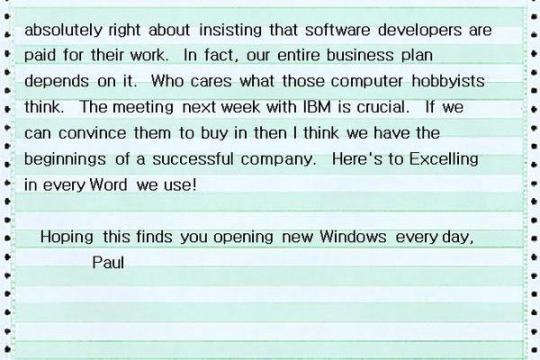
Background clue: Dot matrix printer paper!
Text clues: ‘insisting that software developers are paid’ and ‘Who cares what those computer hobbyists think’- Gates and Allen’s early work on Altair BASIC was widely pirated by early computer hobbyists. Gates insisted on copyright claims, angering some of those computer builders. ‘meeting next week with IBM’- The July, 1980 contract between IBM and Microsoft set up at IBM as the major player in computer hardware and Microsoft in the same position on software. ‘Excelling’ and ‘Word’- Microsoft Excel and Microsoft Word are two of the company’s flagship products.
Hoping this finds you reference: Microsoft Windows is the key product powering the company.
Signatory: Paul Allen is co-founder of Microsoft.
Slide #15: Margaret Thatcher

Background clue: Buckingham Palace letterhead.
Text clues: ‘brave men and women in the Falklands’- Thatcher was PM during the UK-Argentina Falklands War; ‘handling of the Hong Kong negotiations’- Thatcher negotiated the terms of the Hong Kong transfer to China at the end of the agreement for British control of the city; ‘Sending you, Dennis, and the children all my best’- A reference to Thatcher’s husband and their kids.
Hoping this finds you reference: Thatcher was famously known as the ‘Iron Lady’.
Signatory: Queen Elizabeth II. I was unsure how she would sign her name in such a note, but found several example of letters to political figures that she signed simply, ‘Elizabeth’.
Slide #16: Pete Best

Text clues: ‘Epstein thinks’- Brian Epstein was the Beatles manager’ ‘great chance at Decca’- The Beatles breakthrough recording session came at Decca’s recording studios, but it was also the end of Best’s tenure with the band; ‘My Bonny’- One of the Beatles early recordings was a cover of ‘My Bonny’ and it gained them some attention at Decca; ‘George is working on some new stuff’- A passing reference to George Harrison; ‘The drummer is always key’- Best was the drummer, and his perceived shortcomings in that key role led to his dismissal; ‘You’re the...’- Just a play on words on Best’s name; ‘sure that you’ll be a Starr’- Best’s replacement was Ringo Starr.
Hoping this finds you reference: Best would not remain a member of the band.
Signatories: John Lennon and Paul McCartney
Slide #17: George Lucas

Background clue: Stephen Spielberg formed Amblin Entertainment in the early 1980s shortly before the release of E.T.
Text clues: ‘take on directing the second part of your space opera’- Lucas had decided not to direct after A New Hope. There were some discussions with Spielberg, but the latter never directed a Star Wars film; ‘two pending sci-fi projects of my own’- E.T. and Poltergeist; ‘and the Indy sequel’- Temple of Doom was released in 1984; ‘Kershner or Marquand’- the eventual directors of Empire Strikes Back and Return of the Jedi; ‘Crichton and I are discussing a project that we might need ILM on’- Spielberg directed the movie version of Crichton’s ‘Jurassic Park’ in 1993 and ILM did the special effects. In reality, they would not discuss the novel until October 1989, shortly before its release; ‘Tell Harrison not to hurt himself’ and ‘behind the whip again’- References to Ford starring in in both Star Wars and Indiana Jones.
Hoping this finds you reference: The Force was with Lucas to the tune of a $4 billion sale to Disney.
Signatory: Steven Spielberg
Slide #18: Mary Shelley
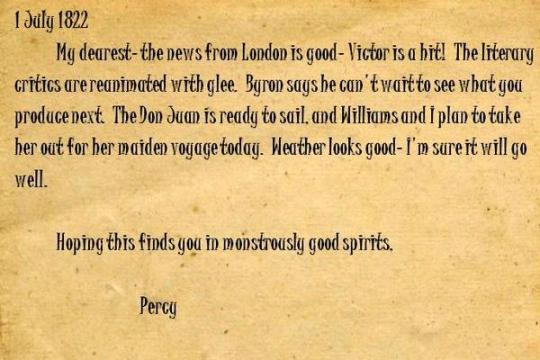
Text references: ‘1 July 1822′- The date of Percy’s death; ‘news from London is good- Victor is a hit’- Mary’s novel ‘Frankenstein’ was released in 1822 to much acclaim; ‘Byron says he can’t wait to see what you produce next’- The poet Byron was a close friend of the Shelleys; ‘The Don Juan is ready to sail’- Percy’s ill-fated boat was named the ‘Don Juan’; ‘Williams and I plan to take her out’ and ‘I’m sure it will go well’- Percy and his friend Edward Wiliams launched the boat on July 1, 1822. It sank and they were both killed as was a young deckhand they brought with them.
Hoping this finds you reference: Frankenstein was monstrously good.
Signatory: Percy Bysshe Shelley, Mary’s husband.
Slide #19: David Livingstone:

Text clues: ‘dispatched by the New York Herald’- Stanley’s expedition to find Livingstone was funded by the New York paper; ‘sail to Zanzibar in March’ and ‘try to locate you near Lake Tanganyika’- This was Stanley’s route; ‘anxioiusly await the Herald’s funding’- Stanley was delayed by slow funding from the paper.
Hoping this finds you reference: Livingstone was in Ujiji when Stanley found him.
Signatory: Henry Morton Stanley, speaker of the famous line, ‘Dr. Livingstone, I presume?’
Slide #20: Dr. Martin Luther King, Jr.

Background clue: Attorney General Letterhead
General note: I was hesitant about this one. King and Bobby Kennedy were not close friends, and subsequent to their deaths have been described as ‘arms-length’ and ‘quiet rivals’. I was careful to try not to suggest a closer relationship between them than actually existed.
Text clues: ‘Jack how good it was to see you in the Rose Garden’- This should immediately give the timeline as 1961-1963 and MLK was actually in the Rose Garden on June 22, 1963; seeking intervention for the SNCC’- President Kennedy was asked to intervene on behalf of the Student Nonviolent Coordinating Committee; ‘reached out to John Lewis’- A young Lewis was the SNCC leader and this clue should further help with timeline and subject matter; ‘formal proposal for the Civil Rights Act’- That proposal was in June 1963, contemporaneous to King’s Rose Garden visit; ‘southern trips- Miami, Tampa, Dallas’- JFK made those exact trips in November 1963, culminating with his assassination in Dallas, though they were more campaign stops than trips in support of the Civil Rights Act; ‘Washington March next month’- King’s legendary ‘I Have a Dream’ speech was made in August of 1963 during that march; ‘everything that you are dreaming of’- A reference to that speech.
Hoping this finds you reference: A nod to King’s ‘Been to the Mountaintop’ speech, delivered the night before his assassination in 1968.
Signatory: Robert Kennedy, then U.S. Attorney General
4 notes
·
View notes
Photo

Rue Becquerel, Paris, oil on canvas, 18 by 21 1/2 in. Original Art on Auction...Link: http://stores.ebay.com/GALLERY-ANT
#paris#paris cityscape#parisienne#art#oil painting#contemporary art#contemporary painting#contemporary artist#contemporary oil paintng#turner#neal turner#nturner#nealturner#oilpainting#artist#cityscape
2 notes
·
View notes
Text

Codex Urbanus, Canis Pacificus, rue Becquerel, Montmartre street art, Paris
#codex urbanus#codexurbanus#streetart#graffiti#street art#vandal#arturbain#montmartre#paris graffiti#streetartparis#picoftheday
2 notes
·
View notes
Photo

Sτяεετs..// . Some new artworks in Montmartre streets.. 〰️ . Artwork | Lίl’ Sυηηγ Ναρ Νº 8 Artist | @darksnooopy Details | 1 x 1 - Spray on Paper . Abstract Calligraphy Art | Rue Becquerel, Paris 18 | 2018 (à Rue Becquerel) https://www.instagram.com/p/Bn8PNYqFWus/?utm_source=ig_tumblr_share&igshid=1unks7iwi7z1m
2 notes
·
View notes
Text


Plaque en hommage à : Edmond Becquerel
Type : Lieu de travail
Adresse : Jardin des Plantes, 57 rue Cuvier, 75005 Paris, France
Date de pose : Inconnue
Texte : Ici en 1839, Edmond Becquerel a découvert l'effet photovoltaïque
Quelques précisions : Edmond Becquerel (1820-1891) est un physicien français. Il est connu pour avoir découvert l'effet photovoltaïque en 1839 et pour avoir créé la première photographie couleur en 1848. Il fut professeur au Muséum national d'histoire naturelle et Président de l'Académie des sciences. Son fils Henri fut également physicien (une plaque, proche de celle présentée ici, commémore sa découverte de la radioactivité).
#individuel#hommes#travail#scientifiques#physicien#france#ile de france#paris#edmond becquerel#non datee
2 notes
·
View notes
Photo

•Gala et Paul Eluard, 1917 Février 1931 (Lettre de Paul Eluard à Gala) Ma Gala, ma seule, ça ne va pas mieux. Hier, trop démoralisé, je me suis «absenté». J’ai été coucher rue Becquerel. J’y ai trouvé ton fantôme, celui de notre vie, de notre vie entière si difficile, si pleine de larmes et de caresses, si pleine de toi. Il te faudrait un manteau rouge, des bas noirs, des gants rouges, un masque rouge, des cheveux fuyants, la tête renversée et nue dans ton manteau et moi mort à tout le reste, à tout ce qui n’est pas toi, ma vie véritable, l’amour que j’ai de tes yeux simples et doux, de tes mains bonnes et belles, de tes seins qui sont pour me troubler plus doux encore que les poils de ton sexe, que ton sexe que j’adore. Ma belle tête, ma toute petite tête, petit crâne tout entier dans ma main, Gala, ma divine Gala, toute ma vie, ma mort, je ne rentrerai plus rue Fontaine, le jour te ressemble trop et la nuit a trop ton odeur, je t’aime, je t’aime, mon enfant, moi-même, Gala.
10 notes
·
View notes
Text
Vintage Women in Science: Marie Skłodowska Curie

[1], Public Domain, Link
Hi all, I’m back with the Vintage Women in Science series, and this is the second post featuring none other than the most famous woman scientist Marie Skłodowska Curie. I struggled to compose this post as so much has been written and told about this lady, and I don’t want to be repetitive. When I was in Paris I visited the Musée Curie at 5th arrondissement at 1, rue Pierre et Marie Curie and I wasn’t quite prepared for the wave of emotion that hit me. Not only I was there on the ground where Curie conducted her research, I was in her garden - one she loved and nurtured herself. I must admit I fought back tears thinking about how I was standing in such a historical site - a place where she paved the way for many women scientists including myself. But we shall slow down - let’s go through this journey together.

When I say women scientists, who do you think of? I bet most of you will answer Marie Skłodowska Curie. Well, Google agrees. Typing “woman scientist” into the search bar comes up with Madam Curie as first result, and her name is so well known sometimes I think we forget why she’s so famous. Her discovery of the element radium was so groundbreaking it’s easy to ignore the other element polonium. The latter is named after her home country Poland, a home she had to abandon in pursue of higher education.

Born in Warsaw on November 7,1867 Maria Sklodowska was one of five children in a family that struggled financially. She worked as a governess to support her family, an occupation that suited her passion for knowledge and learning. She didn’t hesitate when presented with the opportunity to move to Paris to attend university, leaving Warsaw to enter Sorbonne University in Paris to study physics and mathematics. A year later she met the love of her life and her greatest collaborator Pierre Curie, and together they worked in a research laboratory at the School of Chemistry and Physics in Paris. Their research project was to investigate the invisible rays emitted by uranium, a recently discovered element.

The spontaneous rays arises from uranium was the subject of her thesis, and she used an electrometer to measure the electric charge. She discovered that uranium rays caused the air surrounding the sample to conduct electricity, also noticing that the activity of the compounds depended on the quantity. Her hypothesis is that the radiation was not due to the interaction of molecules but a result of the atom itself. This hypothesis is important in disproving the ancient theory that atoms were indivisible. This idea revolutionises the scientific world and created the field of atomic physics. She coined the term "radioactivity" to describe this phenomenon.


She further investigated a mineral called pitchblende that contains uranium ore, it was observed to be more radioactive than pure uranium. She was convinced that there was something else in the mineral that causes the high radioactivity. Pierre and Marie started looking for this unknown element and eventually discovered a new chemical element polonium in 1898. They, however, never managed to isolate the pure form of polonium. The liquid left behind after the extraction turned out to still be highly radioactive, and discovered another new element that is radioactive but in even smaller quantities - the radium. This element was discovered in 1902 after painstaking research conducted in University of Paris. It was 8 years later in 1910 that she successfully isolated pure radium. The Curies were prolific in their publications, writing and publishing a total of 32 scientific papers between 1898 and 1902. One of their publication reports that diseased, tumor-forming cells were destroyed faster than healthy cells when exposed to radium. They recognised the potential of using radiation in treating cancer. This discovery was seen as a miracle by the public, perpetuating the popularity of radium and radioactivity in commercial products


It is worth noting that her two discoveries came before she was even awarded her doctorate in June 1903. In December 1903 Pierre and Marie were awarded the Nobel Prize in Physics for their work on radioactivity. She was the first woman to receive Nobel Prize and later in 1911 she was awarded Nobel Prize in Chemistry after the isolation of pure radium, making her the first person to win two Nobel Prizes. In her later years, she headed the Radium Institute, located next to the museum I visited. The Musée Curie displayed her laboratory and office, and tells the history of Curie research and the great impact the research has on medical advancement. I particularly love the display on her laboratory members and how she was a supportive mentor.


Marie Skłodowska Curie faced many challenges during her career as a woman scientist. Early in her career she considered moving move back to Poland but was refused a place at Krakow University because she was a woman. In 1903 after the discovery of both uranium and polonium Pierre was invited to give a talk at the Royal Institution in London. Marie, however, was not invited as she was a woman and Pierre went alone to this presentation. In December of the same year, Marie was almost skipped from being awarded the Nobel Prize. Gösta Mittag-Leffler, a mathematician who was in the committee and was a supporter of women scientists, alerted Pierre to this and Pierre complained about the lack of recognition. She received the nomination and together with Pierre and Henri Becquerel they were awarded the Nobel Prize. Later in 1911 the French Academy of Sciences also refused to welcome her into the society, and it wasn’t until the 60s where they finally allowed women in. Throughout her life she has faced much opposition from male scientists and even had her personal life scandalised and used against her scientific achievements. After Pierre's death she had a relationship with another scientist that was estranged from his wife and was labeled a homewrecker by the tabloids.

I can say that I am glad nowadays we remember Marie Skłodowska Curie as a great scientist, an empowering woman, the mother to another great woman scientist Irène Joliot-Curie, and someone who has greatly contributed to medical sciences through her work. Marie Curie Hospital was opened in 1930 to focus on radiotherapy for cancer patients and it eventually became the Marie Curie Memorial Foundation. Visiting her laboratory in Paris was an amazing experience and I have really enjoyed learning about her history and achievement. I hope you've also enjoyed this post as this is the last one of this year but I have many more ideas for next year. I'm really looking forward to your comments and suggestions too - thanks!

Dress - 1970s Laura Ashley - eBay
Earrings - Georg Jensen




#vintage women in science#vwis#science#scientist#stem#nobel prize#marie curie#paris#polish#french#chemist#physicist#norafinds#museum
3 notes
·
View notes
Photo

L U M I È R E B O N N E J O U R N É E (light. good day) . . . . . . . . . . . . . . . . . . . . . . . . . . . . . . . . . . . . . . . . . . . . . . . . . . . . . . . . . . . . . . . . . . . . . . . . . . . . . . . #Paris #paris_focus_on #france4dreams #bestsunsetpics #street_focus_on #total_city #loves_united_street #loves_united_paris #thehub_street #streetparis #street_photography #best_streetview #bestfrancepics #bns_paris #loves_paris #ig_paris #_loves_paris_ #parigi #paris_enthusiasts #super_france #igersparis #beautifuldestinations #bestfrancepics #pariscityvision . . . . . . . . . . . . . . . . . . . . . . . . . . . . . . . . . . . . . . . . . . @paris_maville @shared_streets @vivreparis @igersparis @le_bonbon @pariszigzag . . . . . . . . . . . . . . . . . . . . . . . . . . . .. . . . . . . . . . . . . . . . . . . . . . . . . . . .. . . . . . . . . . . . . . . . . . . . . . . . . . . . Rue Becquerel #montmartre #paris18 (à Paris, France) https://www.instagram.com/p/BzKIdW-IHDM/?igshid=nzwi37ymofy1
#paris#paris_focus_on#france4dreams#bestsunsetpics#street_focus_on#total_city#loves_united_street#loves_united_paris#thehub_street#streetparis#street_photography#best_streetview#bestfrancepics#bns_paris#loves_paris#ig_paris#_loves_paris_#parigi#paris_enthusiasts#super_france#igersparis#beautifuldestinations#pariscityvision#montmartre#paris18
0 notes
Text
Other: SouthAfrica.Volunteers.EvolutionSmallMammals
Volunteers needed for the period Oct /Nov 2017 to April 2017 Evolution and Socio-Ecology of small Mammals in the Succulent Karoo of South Africa Opportunity: This is a great opportunity for anybody who wants to get more experience in field work related to animal behavior, evolution, eco-physiology, and ecology before starting an MSc or PhD project. Project: We study the evolutionary and ecological reasons as well as physiological mechanisms of group living, paternal care, communal nesting and social flexibility in the striped mouse. One focus is on the adaptation to droughts, combining physiological, behavioral, ecological and evolutionary research. As this species is diurnal and the habitat is open, direct behavioral observations in the field are possible. What kind of people are needed? Applicants must have an interest in working in the field and with animals. Hard working conditions will await applicants, as the study species gets up with sunrise (between 5 and 6 AM), and stops its activity with dusk (7 PM). Work during nights might also be necessary. Work in the field will be done for 5 days a week. Applicants must be able to manage extreme temperatures (below 0 at night in winter, sometimes over 40C during summer days). Applicants must both be prepared to live for long periods in the loneliness of the field and to be part of a small social group. Work of volunteer field assistants: Trapping, marking and radio-tracking of striped mice; direct behavioral observations in the field. Volunteers will also see how blood samples are collected for physiological measurements. Volunteers are expected to help with maintenance of the research station (water pump, solar power, etc.). Confirmation letter: Students get a letter of confirmation about their work and can prepare a report of their own small project to get credit points from their university for their bachelor or masters studies. Costs: Students have to arrange their transport to the field site themselves. Per month, an amount of Rand 1600 (around 110 Euro) must be paid for accommodation at the research station. Students must buy their own food etc in Springbok. Including extras (going out for dinner; shopping), you should expect costs of about 450 Euros or 600 US$ per month. Students get an invitation letter which they can use to apply for funding in their home country. Place: The field site is in the Goegap Nature Reserve near Springbok in the North-West of South Africa. The vegetation consists of Succulent Karoo, which has been recognized as one of 25 hotspots of biodiversity. It is a desert to semi-desert with rain mainly in winter (June to September). When and how long: We are looking for volunteers to start in Oct / Nov 2017 as well as beginning of 2018. Volunteers are expected to stay for a minimum of 2-3 months, though longer periods are preferred. How to apply? Send a short motivation letter stating why and for which period you are interested and your CV via email to [email protected]. Dr. Carsten Schradin, DR2, http://bit.ly/19o1HJN Video presentation: https://www.youtube.com/watch?v=vZmAXySr-EM Institut Pluridisciplinaire Hubert Curien, Dpartement d'Ecologie Physiologie et Ethologie, 23, rue Becquerel, UMR 7178 CNRS UdS, 67087 Strasbourg cedex 2, France Tel: +33 (0)3 88 10 69 19 Titularprofessor, University of Zurich, Switzerland, http://bit.ly/1VKNzr4 Honorary Professor at the University of the Witwatersrand, Johannesburg, South Africa Director of the Succulent Karoo Research Station http://bit.ly/157Nizq Carsten Schradin via Gmail
0 notes
Text
Une remise de lettre à la société SEM, propriétaire du bâtiment occupé par des demandeurs d'asile
Une remise de lettre à la société SEM, propriétaire du bâtiment occupé par des demandeurs d’asile
[ad_1] 2020-07-09 01:17:57 Source
Une cinquantaine de personnes, habitant.es et soutiens, sont venues assister à la remise du courrier adressé à l’entreprise propriétaire du bâtiment occupé par des demandeur, d’asile rue Becquerel. le lieu devient est expulsable à partir du 10 juillet suite à une procédure passée en référé au tribunal au mois de juin. Il s’agit en fait d’uen demande de…
View On WordPress
0 notes
Text
Corps retrouvé dans un chariot à Rennes : un deuxième homme mis en examen
Un deuxème homme a été mis en examen lundi soir, dans l’affaire du corps retrouvé dans un chariot de supermarché à Rennes, lundi 16 mars. Il avait été interpellé en même temps que le premier suspect, mais avait été emmené à l’hôpital.
Deux hommes sont désormais suspectés, après la mort d’un homme de 37 ans, retrouvé mort, brûlé, dans un chariot de supermarché, rue Antoine-Becquerel, dans le…
View On WordPress
0 notes